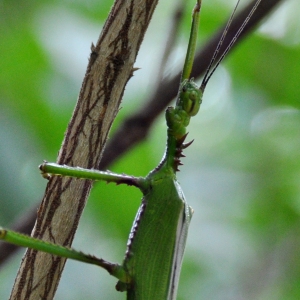During a pruning frenzy yesterday I came across this rather large Spiny Leaf Insect or Macleays Spectre (Extatosoma tiaratum). She was looking decidedly nervous as I approached enthusiastically with my secateurs, snipping away at branches and so removing leaves she had been happily feeding upon.


I don’t blame her for feeling under threat as she was left somewhat exposed, despite her good camouflage. Needless to say I changed course and left that area of the garden for another day. Luckily we have planted quite a number of Xanthostemon verticillatus as it appears to be a favourite food for a variety of stick insects. A quick check today has revealed that she is on the same bush but safely tucked under some green cover. This garden surrounds the pool where I found a male Spiny Leaf Insect in 2013. Which leads me to wonder if I need to improve my powers of observation ….. or perhaps I haven’t been spending enough time tending to the shrubs in that garden.
And in other news ……….. the Amethyst python curled up around her eggs since November last year has now moved on. My granddaughter and I checked under the cover on Jan 1st and both snakes were there. When I checked on Jan 3rd the Carpet Snake was still guarding her eggs but only the empty shells of the Amethyst were left. No sign of young snakes and no sign of the adult. The Carpet snake is still curled up in the same area but in recent days I have seen her stretched out and I can see her eggs are empty. We have no idea why she remains in the same position.












